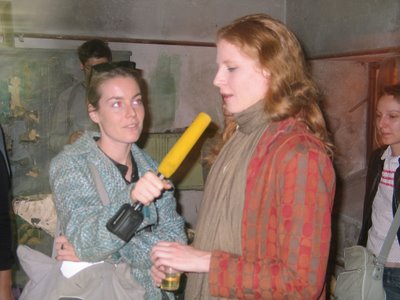Wojciech Pustoła likes tension. He is an avid listener of Shostakovich - and not of the pretty fugues of the composer's last period. No. He likes when the guts are spilling over, when the pain isn't even sublimated, when it's there, bare. He sculpts dogs. Various positions, sizes. There is a nervousness in the form, an irritating intensity, like when someone keeps the flashlight pointing to your eyes.
Wojciech Pustoła prepares his final presentation - the one that will correspond to an academic thesis. The dogs are ready.
 But he doesn't wait till the day of presentation. Instead, he organizes a vernissage a few days earlier. He invites the broadest range of people possible: art curators, family, security guards, businessmen, construction workers from a site nearby, distant relatives...
But he doesn't wait till the day of presentation. Instead, he organizes a vernissage a few days earlier. He invites the broadest range of people possible: art curators, family, security guards, businessmen, construction workers from a site nearby, distant relatives...

 There is, of course, an opening ceremony...
There is, of course, an opening ceremony... ...during which the artist speaks about everything one expects him to - and more...
...during which the artist speaks about everything one expects him to - and more...
...then everyone procedes to see the sculptures

While the spectators are discovering the works, a few people with microphones circulate, asking questions.

 Some of the questions are: Can you descroibe the best work here to someone who isn't seeing it? Why is it so dark in here? What texture do you like objects to have? Why? Do you ever feel like touching objects? Do you think it depends on you or on the objects? Doesn't this pink wall irritate you? Why dogs? Is there any work you don't like particularly? Can you describe it to someone who isn't here?
Some of the questions are: Can you descroibe the best work here to someone who isn't seeing it? Why is it so dark in here? What texture do you like objects to have? Why? Do you ever feel like touching objects? Do you think it depends on you or on the objects? Doesn't this pink wall irritate you? Why dogs? Is there any work you don't like particularly? Can you describe it to someone who isn't here?The jury is also invited. I haven't received any information on whether the jury was present or not. But this is not the presentation. The presentation, as I mentioned, comes a few days later. The jury arrives. You guessed it: the room is empty. Not a sculpture in sight. There are a few speakers spread through the space. Each of them has fragments of the recorded interviews. And that is all the jury gets.
Here is what happened:
"it all went great, very human, people started talking and having conversations, the jury was completely blown away, all these simple folks discussing about the meaning of art, like children"
 Like children. This is what I like about it. What could have become a somewhat annoying conceptual work about absence became a reminder of the experience of art. Of our contact with it, and how much an unfinished dog with square legs can mean to us. Even once its gone.
Like children. This is what I like about it. What could have become a somewhat annoying conceptual work about absence became a reminder of the experience of art. Of our contact with it, and how much an unfinished dog with square legs can mean to us. Even once its gone.Technorati:

0 comments:
Post a Comment